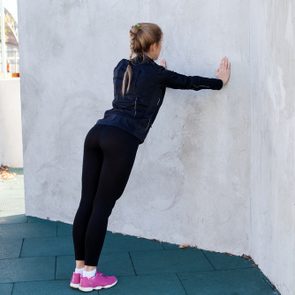5 Easy Exercises Seniors Can Do at Home
Updated: Mar. 16, 2022
It's never too late to start exercising—and the payoffs are big. Here are some simple exercises older adults can do at home.
The benefits of exercise for aging
If you’re nearing retirement age or older, even if you haven’t been active, now’s a great time to start. Exercise at any age can help prevent, limit, and even reverse many age-related changes in quality of life.
According to the government’s 2018 Physical Activity Guidelines Advisory Committee Scientific Report, regular physical activity performed by older adults can help prevent falls and fall-related fractures and other injuries, and can help improve physical function and reduce age-related loss of physical function.
What’s more, the same report noted varying levels of evidence (from limited to strong) that regular exercise, including strength training, tai chi, and qigong, helped improve physical function in those with cardiovascular disease, chronic obstructive pulmonary disease, cognitive impairment, frailty, hip fractures, osteoporosis, Parkinson’s disease, and stroke.
This is incredibly important information because it underlines the role of exercise in improving health at every age.
Assuming you have the green light from your doctor to pursue an exercise program, aim to get active on a consistent basis. Even a little bit of regular physical activity can make the aging process a little less challenging. And that’s something to get excited about.
Get more exercise from your daily activities
The first thing to keep in mind is that any activity—no matter how little—is better than none.
So while the Centers for Disease Control and Prevention (CDC) recommends at least 150 minutes of moderate-intensity cardiovascular exercise per week, with an additional two days a week of muscle-strengthening exercise, it’s okay to start with a level that feels attainable to you.
(Don’t forget to include stretching! Here are the 5 best stretching exercises for seniors–or anyone feeling achy.)
Start by moving more
A big part of achieving the recommended 150 minutes of weekly exercise is simply moving more. You know those hobbies you love? If they keep you moving, they count toward your weekly total.
If your interests skew toward the sedentary (hey, there’s nothing wrong with reading!), think about picking up an active hobby. That might include golfing, gardening, playing outdoor games with your grandkids, walking the dog, or even shopping with friends (assuming you spend more time walking briskly around the store than digging through the racks).
Even “boring” movement counts—you’d be surprised how many calories you burn cleaning the house.
Make sure your activity counts as cardio
To enjoy cardiovascular benefits, the minutes of exercise you perform should be done at a moderate or vigorous level of intensity.
Not sure how to gauge your intensity? Use a 10-point scale to assess your personal exertion level. A zero on the scale would be the equivalent of lying down doing nothing, while a 10 would be an all-out effort. Moderate-intensity exercise falls around a five or six on this scale, while a seven or higher is considered vigorous.
If you can rack up roughly 30 minutes of moderate-intensity cardio a day, five days a week; 15 minutes of vigorous-intensity cardio a day, five days a week; or some equivalent combination thereof, you’ll be meeting the CDC’s suggested cardio guidelines.
Don’t forget to strength train
The only other piece of the puzzle you have to consider is how to include strength-training exercises into your routine.
You don’t have to hit the gym to enjoy a solid strength-training workout. There are lots of easy, home-based exercises you can perform with basic equipment, like resistance bands or dumbbells. And in many cases, you can simply use your own body weight.
The important thing is to target each of your major muscle groups at least two times a week. Even a 20-minute strength-training session can do the trick.
Jeanette DePatie, a fitness instructor and senior specialist with the workout video Everybody Can Exercise: Senior Edition, points to the following exercises as a good place to start. Find a clear place in your home, and give them a try.
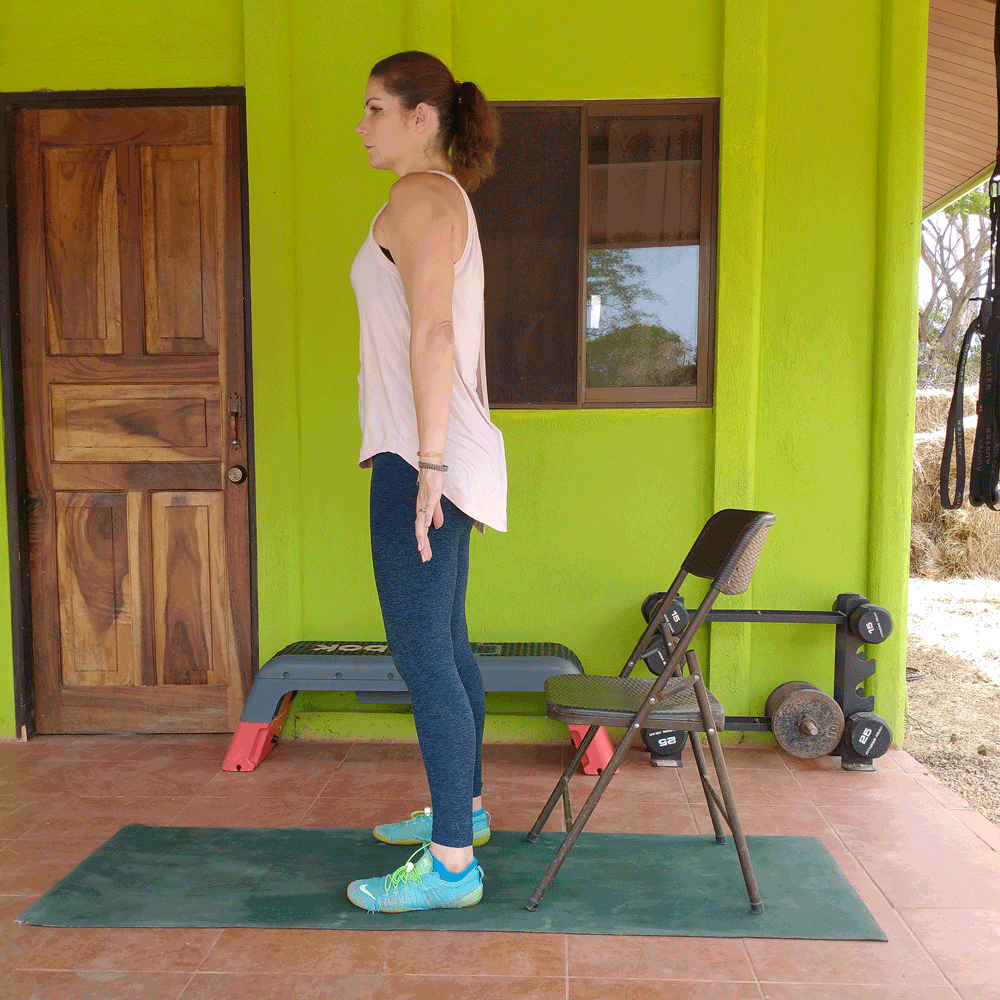
Chair squat
Going from a seated to a standing position (and vice versa) is one of those everyday movements that targets your glutes, hamstrings, quads, and even your core. It also requires balance and coordination. The chair squat requires nothing more than a sturdy chair.
Aim to perform the exercise without the help of your arms or upper body. Need the extra help at first? That’s totally fine. You can use a chair with armrests to give you something solid to press off of.
Stand in front of a chair, your back to the seat. Position your feet hip-distance apart and check your posture. Pull your shoulders back, tuck your hips slightly forward, and slightly bend your knees.
Take a breath in and press your hips backward, bending your knees as you steadily lower your butt toward the seat of the chair. Allow your arms to rise in front of you to help with balance as you sit back. Keep your knees aligned with your toes as you sit.
When your butt touches the chair, rest for a beat, then press through your heels to return to standing. If you need to, press your hands on the armrests or the seat of the chair on either side of your hips. Be sure to distribute your weight equally on each side.
The most important part of this exercise is the slow, controlled downward phase, so take extra care with this step. Perform two to three sets of eight to 10 repetitions.
(Want to do more? Try these other squat exercises.)
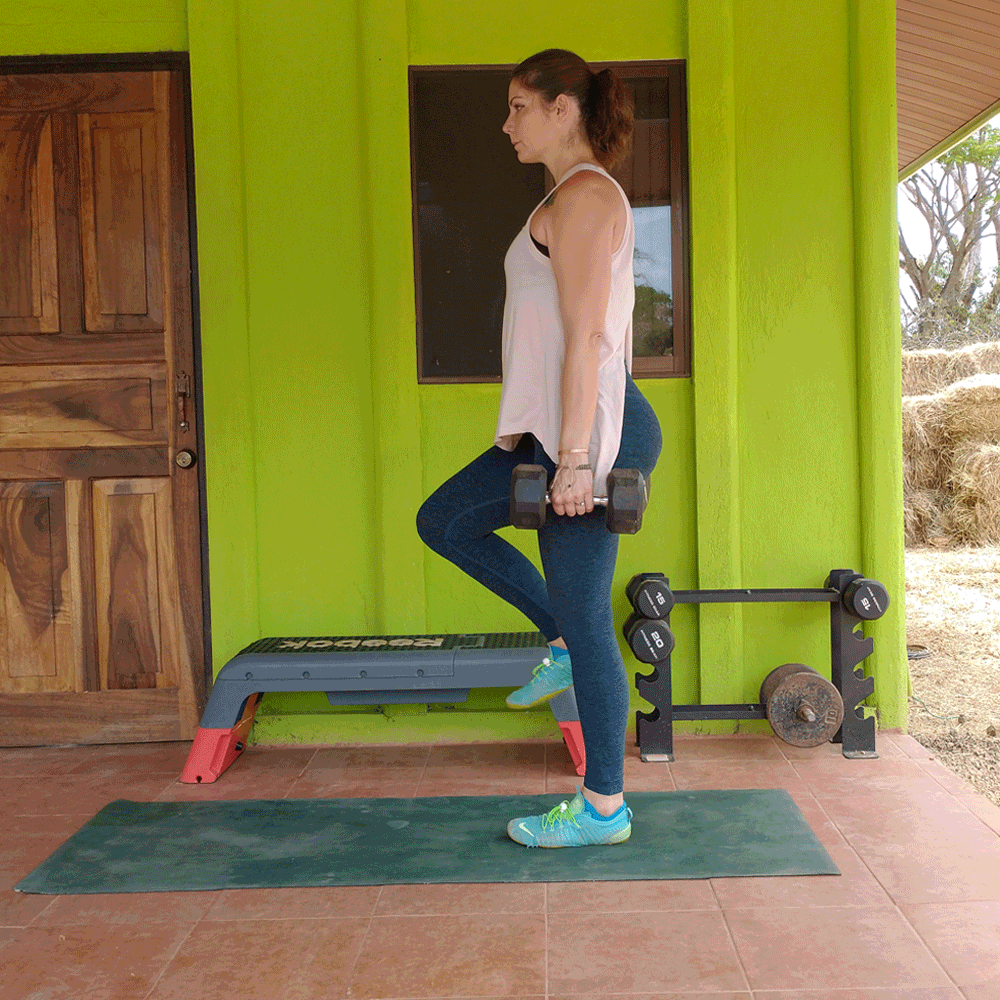
Farmer’s walk
The farmer’s walk exercise helps improve balance and coordination for walking movements, while also increasing strength in your lower body, core, back, forearms, and grip. Use a set of dumbbells (water bottles also work) to add resistance to the exercise.
Stand tall, focusing on your posture. Engage your core, rolling your shoulders back and tightening your abs like a corset (drawing them back toward your spine). Hold a dumbbell in each hand.
Steadily and with control, begin walking forward, exaggerating each step. The goal isn’t to take longer steps but to lift the knee and foot a little higher than you would usually lift them.
Take 10 to 20 steps forward. Rest, then repeat two more times.
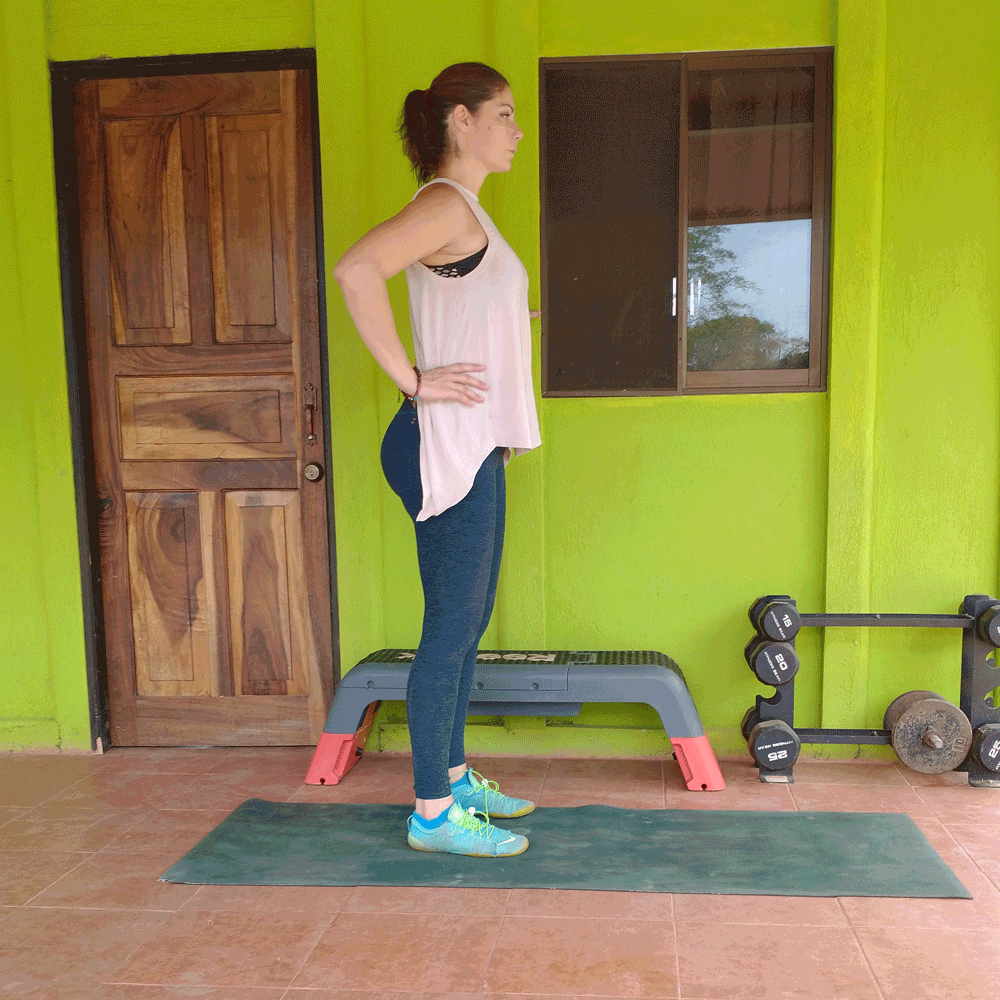
Single-leg balance stand
Balance exercises are incredibly important for helping reduce the risk of falls while also improving core strength, side-to-side strength, and proprioception (your ability to sense your body’s location and actions) for day-to-day movements.
Stand tall with good posture, your feet hip-distance apart. If needed, place your hands lightly against a wall or sturdy chair back for balance. Shift your weight slightly to the left and carefully lift your right foot from the floor in front of you, drawing your knee forward to a 90-degree angle without moving your torso or changing your posture.
Hold the position for as long as you can, aiming for 20 to 40 seconds. Perform two to three sets per side.
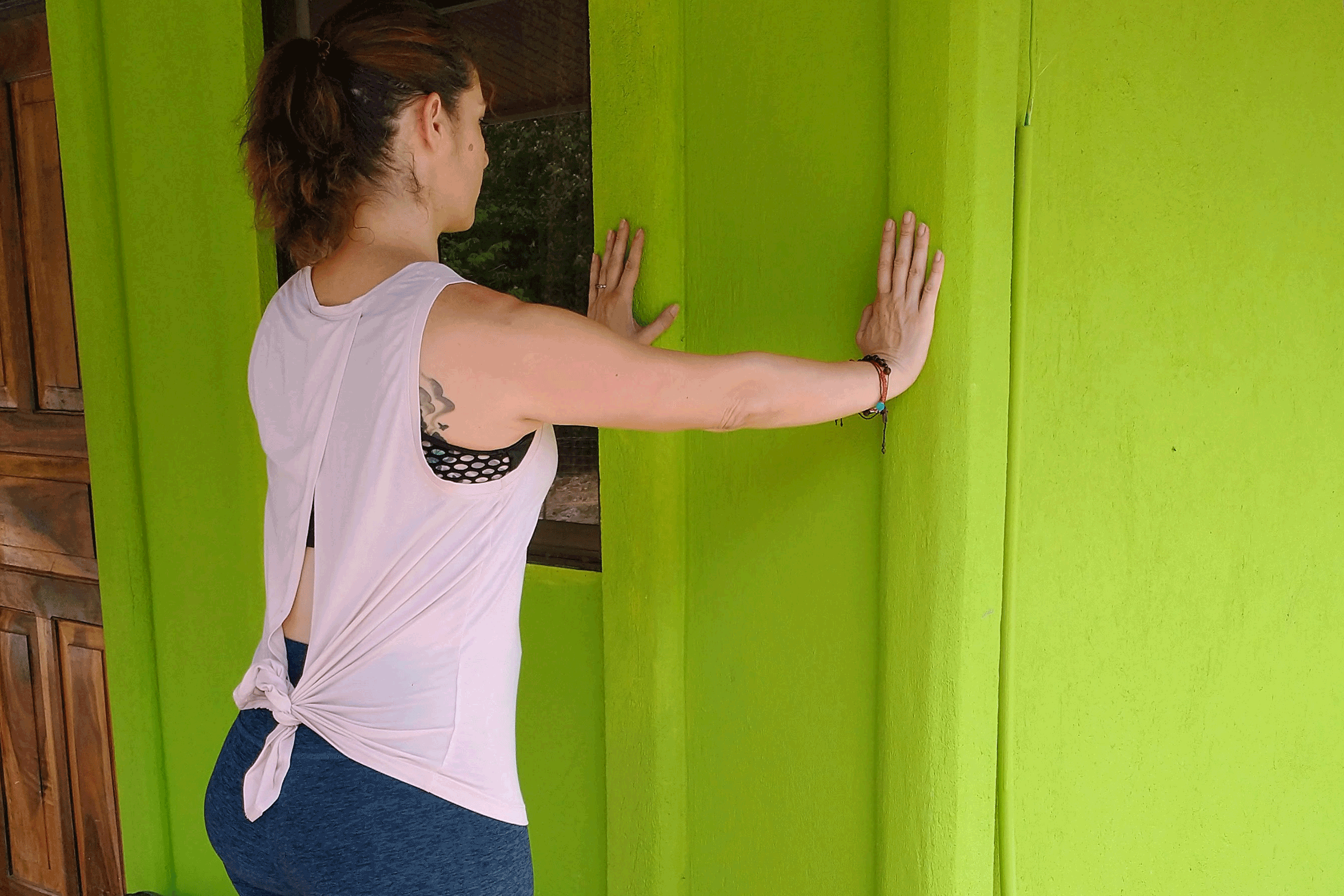
Wall or incline push-up
To work on upper-body strength, particularly through your chest, shoulders, triceps, and core, try wall push-ups. They’re an excellent equipment-free option.
Stand an arm’s length away from a wall. Place your palms flat on the wall at shoulder level. Your arms should be parallel to the ground and your feet roughly hip-distance apart.
Engage your core, pulling your abs in toward your spine. It’s important to keep your abs engaged and your body aligned throughout the exercise. Bend your elbows and move your chest and shoulders closer to the wall. Your elbows should bend backward at a roughly 45-degree angle to your body.
When your shoulders and head are almost at the wall, reverse the movement and press through your palms to push your chest and torso back to the starting position.
Perform two to three sets of eight to 12 repetitions.
The great thing about this move is it’s easy to advance as you gain strength. With time, if you discover wall push-ups are too easy, you can make the exercise more difficult by changing the angle of the move. By using a counter, desk, or the back of your couch, you’ll do the move at a greater incline.
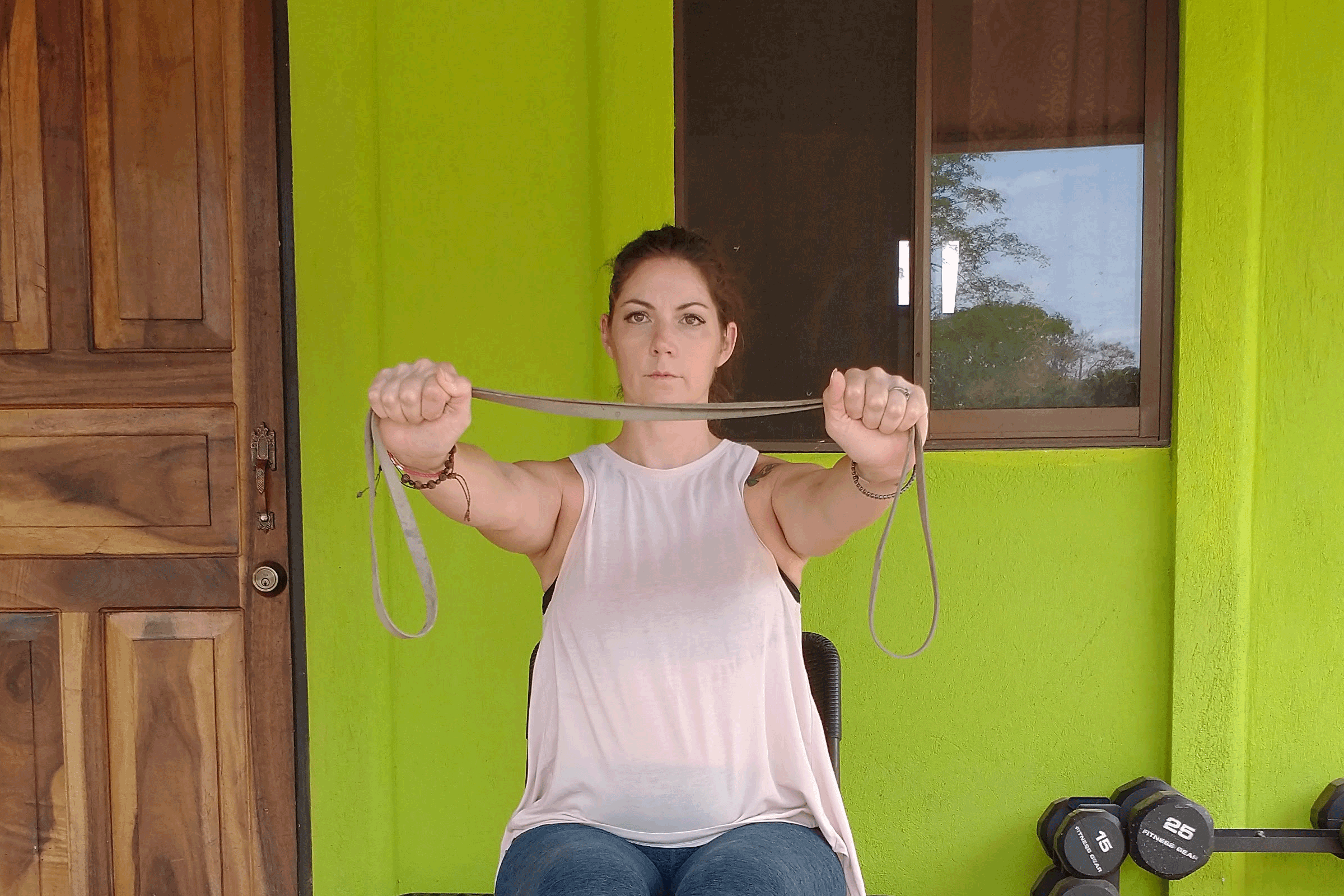
Resistance band pull-aparts
Grab a resistance band for this exercise, which strengthens the back half of your body, including your upper back, shoulders, and core.
Sit in a chair with your feet flat on the floor, roughly hip-distance apart. Check your posture: your ears should be aligned with your shoulders and hips. With both hands, hold a resistance band directly in front of your shoulders, so your arms are parallel to the floor. The band should be taut between your hands, but not tight.
Engage your abs, drawing them back toward your spine. Keeping your torso steady, pull your hands apart, extending your arms out to your sides in a T shape as you squeeze your shoulder blades together.
Hold for a breath, then return to the starting position. Perform two to three sets of eight to 12 repetitions.
If you find that using a resistance band is too difficult, start by doing the exercise without a band. Really focus on squeezing your shoulder blades together as you move your arms into the T position.
Next, check out these tips when you need exercise motivation.















